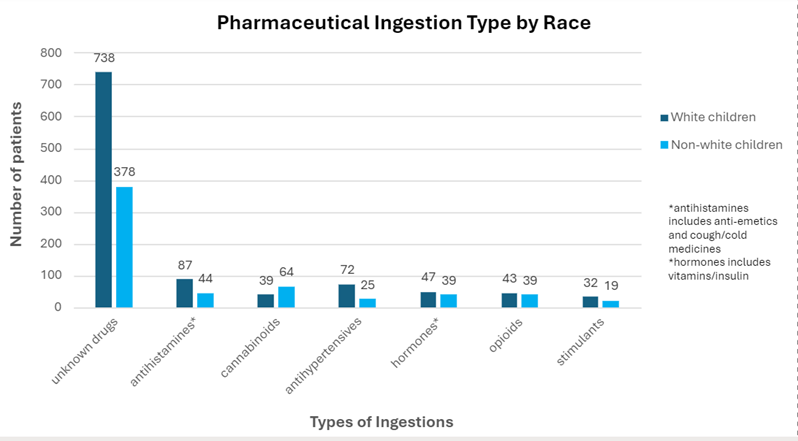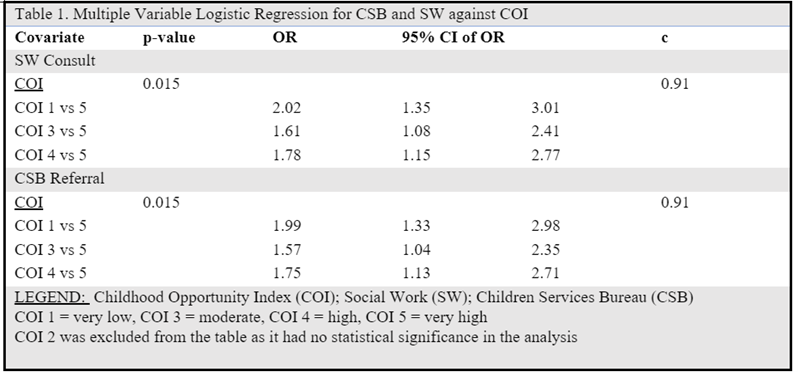Research found that Black children seeking emergency treatment for an unintentional ingestion more likely than white children to be referred for social worker and Children Services Bureau interventions
ORLANDO, Fla.— Unintentional injuries like falls, drownings and poisonings are the leading cause of death in patients ages 1-4, and a significant portion of these deaths are linked to unintentional ingestions—such as swallowing a drug or poison. New research shows racial and socioeconomic disparities exist in the emergency management of unintentional ingestions in children.
Black patients younger than age 6 with the diagnosis of unintentional ingestion were more likely than white children to have a social work consult, Children Services Bureau referral, and urine drug screen, according to a research abstract, “Disparities in the Emergency Evaluation and Management of Unintentional Ingestions in Preschool Children,” presented during the American Academy of Pediatrics 2024 National Conference & Exhibition at the Orange County Convention Center from Sept. 27-Oct. 1.
The research also found that children from poorer backgrounds (lower childhood opportunity index), those with higher severity of illness and pharmaceutical ingestions resulted in either a social work consultation, a Children Services Bureau referral, or both.
“This study is important in understanding where underlying bias exists in emergency departments and hospital management and where changes can be made to address this problem, thus providing equitable care for all children,” said principal investigator Jennifer Allen, DO, FAAP. “These findings could be useful to healthcare workers in emergency departments to help develop a framework for standardized clinical decision making.”
Researchers examined the records of 4,411 patients, younger than age 6, who had unintentional ingestions between January 2013 and March 2024 identified by the International Classification of Disease in the electronic health record. They found:
- Most ingestions were non-pharmaceutical (56%)
- Patients with pharmaceutical ingestions had higher odds of a social work consult and a Children Services Bureau referral
- Independent of ingestion type, non-white children were more likely to have a social worker consult or Children Services Bureau referral
- White children were less likely to be exposed to cannabis
- Private insurance was associated with reduced odds of social worker or Children Services Bureau referral.
“This isn’t the only research to find racial disparities in the emergency department,” Dr. Allen said. “Disparity has been identified among different races regarding pain management for fractures and appendicitis in the emergency department.”
Akron Children’s Hospital supported this research.
Study author Dr. Jennifer Allen is scheduled to present this research, which is below, from 2:30 - 2:40 p.m. Friday, Sept. 27, 2024, during the Section on Emergency Medicine program during the AAP’s National Conference and Exhibition. To request an interview with the authors, contact her at jallen@akronchildrens.org, or contact Holly Popino, 330-819-2012, hpupino@akronchildrens.org.
Please note: only the abstract is being presented at the meeting. In some cases, the researcher may have more data available to share with media, or may be preparing a longer article for submission to a journal.
# # #
The American Academy of Pediatrics is an organization of 67,000 primary care pediatricians, pediatric medical subspecialists and pediatric surgical specialists dedicated to the health, safety and well-being of infants, children, adolescents and young adults. For more information, visit www.aap.org. Reporters can access the meeting program and other relevant meeting information through the AAP meeting website at http://www.aapexperience.org/
Abstract
Program Name: 2024 AAP National Conference-Abstracts
Submission Type: Section on Emergency Medicine
Abstract Title: Disparities in the emergency evaluation and management of unintentional ingestions in preschool children
Unintentional injuries consisting of trauma and poisonings are the leading cause of death in patients aged 1-4 years old with a significant portion attributed to ingestions. National Poison Control data in 2021 showed there were 37 incidences of poison exposure per 1000 children under 6 years old (2023). Between 2010-2019, poisoning deaths among minority children increased (West, 2021). Evidence of treatment disparity exists as seen in the decreased use of opioids or analgesia in minority children with long bone fractures or appendicitis in the emergency department (ED) (Goyal, 2015 and 2020). There is a knowledge gap regarding the extent, causes, and impact of disparities in assessing and managing acute ingestions in children. This study aimed to determine whether there is a difference in the evaluation and management of children with unintentional ingestions in a pediatric tertiary care center’s ED.
From January 2013 to March 2024, patients less than 6 years of age were identified by International Classification of Disease (ICD) 9 and 10 codes in the electronic health record (EHR). Independent variables included: race, childhood opportunity index (COI), payor status, severity, age, sex, and substance type. Dependent variables included: urine drug screen (UDS), social work (SW) consult, and child service bureau (CSB) referral. Summary statistics were calculated and described as mean (sd). The relationship between independent and dependent variables was described using odds ratio (OR) with 95% confidence interval (CI). The relationship between pharmaceutical ingestion type was described using the receiver operating characteristic curve (ROC). Significance was defined as p-value < 0.05. Races are defined as White, African American, and Other; due to low numbers in categories comparisons are between all White and Non-White children.
4411 patients had unintentional ingestions and most ingestions were non-pharmaceutical (56%). Patients with pharmaceutical ingestions had higher odds of a social work consult and a CSB referral (OR 8.3, 9.0). Independent of ingestion type, Non-White children were more likely to have a SW consult, CSB referral, and UDS order (ROC 0.78, 0.84, and 0.86). Looking at pharmaceutical ingestions, Non-White children had more cannabis ingestions than White children (Figure 1). Private insurance and ED discharge were associated with reduced odds of SW consults or CSB referral. A lower COI was associated with higher odds of SW consult and CSB referral (Table 1). When adjusted for COI, payor type, and severity, African Americans had higher odds of a SW consult, CSB referral, and UDS order (OR 1.8, 2.8, 2.3).
This study revealed there are racial disparities in the management of unintentional ingestions within the ED setting. The next step would be to discuss findings with ED professionals and develop a framework for standardized clinical decision making.
Figure 1

Pharmaceutical ingestions classified by race (Non-white children vs White Children)
Table 1. Multiple Variable Logisitic Regression for CSB and SW against COI
